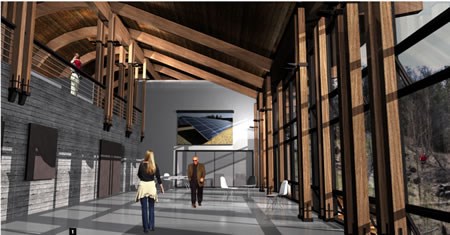The real future of construction across all of North America, lies in the sustainable building sector, according to international “green” building guru David Johnston.
Having traveled to Sudbury as a keynote speaker for the three-day Living Building Conference 2008 held at Cambrian College this fall, Johnston reinforced the idea that, in the years to come, the global demand for green building know-how will rise dramatically.
“Construction numbers in the United States are down pretty much all over, unless you look to the green sector, which is really the only place where construction is occurring,” says Johnston, a best-selling author of two sustainable building books.
“I don’t think it’ll be too long before you see in this Canada, and so building the capacity for this kind of knowledge really is very important. From what I’ve seen and heard, the North seems really well suited for this kind of industry.”
With roughly 100 attendees, the event heard from a variety of luminaries in academia and business, most of which quite happily label themselves as part of the sustainable building movement.
As the founder of the Living Building Challenge, which urges builders to go beyond LEED standards, Jason McLennan counts himself among this group.
As a former Sudburian and the current CEO of the Cascadia Green Building Council, the Seattle-based McLennan emphasizes the need for companies and post-secondary institutions to understand the importance of energy efficient construction.
Buildings account for one-third of the greenhouse gas emissions among the industrialized countries, he says. In the United States, buildings account for half such emissions.
As a result, the need to develop a workforce capable of energy efficient construction is key, he says, particularly as alarms have begun to sound about the state of the planet’s health.
In fact, the Intergovernmental Panel on Climate Change has recently said that the world has less than 10 years to make transformative change before reaching the point of no return.
Fortunately, many companies and communities have responded to this need, even in this time of economic trouble, McLennan says.
Efforts to revolutionize energy efficiency in residential construction have led to the creation of more than 1.4 million jobs in California since 1974, with more than half that number arising within the last four years.
This has been the result of a great deal of lobbying from within the government as well as the private sector, and a similar shift could help move Northern Ontario to a similar state of “green” growth, he argues.
With the impending creation of the Sustainable Energy Centre at Cambrian, as well as the school’s new Energy Systems Technology program, Sudbury is well on its way to making that shift.
“This decade will be the decade of ‘green collar jobs,’” he says. “This college has situated itself for the workforce that the world is going to need, and that’s pretty cool.”




